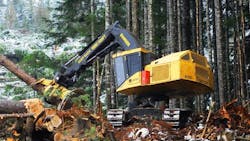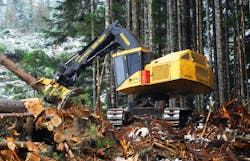Hydraulic Fan Drive Keeps Engine Cool and Efficient
Feller bunchers use hydraulically actuated grippers to secure a tree trunk, employ a hydraulic motor powering a saw to cut the trunk near the ground, and finally use hydraulic cylinders to pull the trunk past blades that cut branches from the trunk. Tigercat International Inc., Brantford, Ont., Canada, builds feller bunchers and a wide variety of forestry and other off-highway equipment that make extensive use of hydraulics.
Tigercat’s 860C and 870C series feller bunchers, for example, incorporate variable-speed hydraulic fan drives to maintain engine coolant within a narrow band of temperatures. Keeping coolant to within a few degrees of the engine’s optimum operating temperature ensures that the engine operates at peak fuel efficiency—even with varying loads and wide swings ambient temperature.
Because it’s driven by a hydraulic motor instead of the engine’s belt drive, the radiator can be placed anywhere on the machine. Therefore, designers located the radiator at the back of the machine, well away from the dirt and debris generated at the saw discharge area. Furthermore, the fan motor is bidirectional, so automatically reversing the air flow through the radiator keeps it clear of dirt and debris that would otherwise block cooling air flow.



